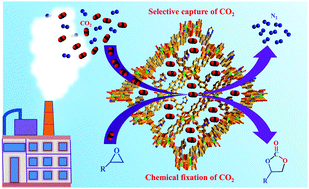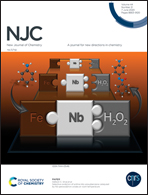Construction of 3D lanthanide based MOFs with pores decorated with basic imidazole groups for selective capture and chemical fixation of CO2†
Abstract
Three new 3D lanthanide-based metal–organic frameworks (MOFs), [Ln2(ImBDC)3(2H2O)]n (where Ln = Tb3+ (1)/Sm3+ (2)/Eu3+ (3), ImBDC = 2-(imidazol-1-yl)terephthalic acid), have been synthesized solvothermally and characterized with single-crystal X-ray diffraction and other physicochemical methods. MOFs1–3 are isostructural and feature a 3D framework structure with 1D channels of dimension 3.91 × 5.27 Å2 decorated with basic imidazole groups. Owing to imidazole functionalized pores, MOF1 exhibits selective adsorption properties for CO2 with a high interaction energy (Qst) of 37.1 kJ mol−1. The activated samples of the MOFs act as efficient heterogeneous catalysts for the cycloaddition reaction of CO2 to epoxides to generate value-added cyclic carbonates. Interestingly, due to the narrow pore channels of the MOFs, preferential conversion of smaller size epoxides over the larger epoxides is observed. Furthermore, the MOF catalyst could be recycled and reused for up to five cycles without significant reduction in the catalytic activity. Thus the present study demonstrates size-selective catalytic activity for the conversion of smaller epoxides to cyclic carbonates under mild reaction conditions.



 Please wait while we load your content...
Please wait while we load your content...